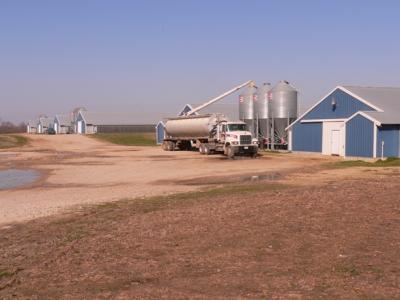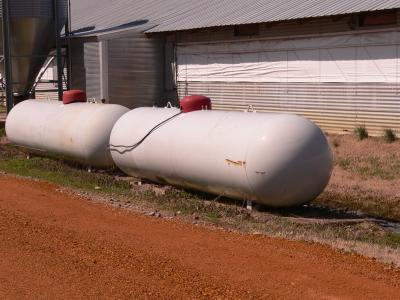Extension: Commercial Poultry Production
Commercial Poultry Production
Poultry is Kentucky's No. 1 agricultural commodity as well as the No. 1 food commodity. Kentucky's chicken meat production (broiler industry) ranks 8th nationally. As a result, the poultry industry has had a major impact on Kentucky's economy.
Poultry is a $900 million industry and each year pays out over $130 million in salaries and over $91 million in payments to contract growers. Kentucky's poultry industry also uses 29% of Kentucky's corn crop and 32% of its soybean crop. Kentucky's grain farmers realize a 10-15 cents per bushel premium from poultry, giving them a $10-15 million bonus for their grain.
There are over 850 poultry farms in 42 counties in Kentucky. The average poultry farm is owned and managed by a family farmer and consists of less than five houses. Over 50% of Kentucky poultry farmers are or were tobacco farmers. As the income from tobacco decreased, farmers included poultry production to diversify their income.
The poultry industry has made large investments in infrastructure in the state, including five broiler hatcheries, two primary breeder hatcheries, six feed mills, four processing plants, three egg production complexes, a rendering plant, and 850 poultry farms with 2,800 houses. Kentucky also serves processing plants in the neighboring states of Tennessee and Indiana.
Kentucky Poultry Energy Efficiency Project
With funding from the Kentucky Agricultural Development Board, the Kentucky Poultry Federation and the University of Kentucky have been involved in a project to help the poultry industry reduce the amount of energy used in broiler production. Today energy bills are one of the major expenditures a poultry producer has. It is estimated that the average utility bill for a poultry house is $700 a month. As the price of propane continues to increase, production costs will also continue to increase, negatively affecting the economic sustainability of poultry producers. The project was developed to address this concern.
The project includes:
- a quarterly newsletter (Cheeps and Chirps)
- a poultry production manual covering a wide range of topics
Resources
Changes in the modern broiler chicken have increased the importance of in-house environmental conditions. In response to market requirements, geneticists have raised growth rate as well as the yield of the carcass components. The extra meat yield in these broilers, most of which is concentrated in the breast, makes the broiler more sensitive to high temperatures, ammonia, and dust. As a result, much of the difference in performance of broiler flocks can be attributed to how well in-house environmental conditions are managed, especially temperature and air quality.
Publications
Lighting is an important part of animal production, including poultry. Light is involved in the daily biological cycles of biochemical, physiological and behavior activities of all animals.
Different animals see light different. This is why chickens and turkeys may behave differently under the same intensity of light from two different sources even if the both lights look the same to us.
Publications
Both beetles and rodents can become a nuisance for neighbors, resulting in complaints to the grower and broiler integrator. The migration of darkling beetles from litter spread on fields has resulted in a number of lawsuits.
In addition, insects and rodents can carry diseases. Control of such pests is an important factor in any biosecurity program.
Publications
Litter Management
Proper handling and storage of poultry litter are needed to preserve its nutrient value and prevent contamination of surface and groundwater, particularly when litter cannot be directly applied to land. Improper handling and storage of poultry litter can result in:
- Loss of nutrients
- Contamination of surface and/or groundwater
- Potential for the spread of disease
- Odor and aesthetic problems
With a little advance planning and minimal investment, these problems can be reduced or eliminated. It is important to follow any and all national, state, county and city regulations with regard to the disposal of waste material.
- Laws and regulations impacting livestock wastes in Kentucky
- Generation and legal regulation of odors from animal manures
- Solid livestock waste regulatory requirements
- Agricultural water quality act: Your responsibilities as a landowner
The most efficient method of handling poultry litter is to directly apply it to fields as it is being removed from the house. This reduces labor, expense and potential environmental problems. This requires cleanout when weather and crop conditions are favorable for applying the litter. For cropland, this time will be in the spring before the crop is planted, or in the fall after the crop has been harvested if a small grain or cover crop is to be planted. Application of litter to cropland during the winter should be avoided because the efficient use of nutrients will be low and the potential for water contamination is increased. Apply poultry litter only in amounts needed to supply the nutrient needs of the crop to be grown. Have the litter as well as soil samples from the fields that are to have litter applied tested to determine how much should be applied.
Resources
- AGR-168: Broiler Litter Production in Kentucky and Potential Use as a Nutrient Source
- AGR-165: The Agronomics of Manure Use for Crop Production
- AGR-146: Using Animal Manures as Nutrient Sources
- ID-148: Sampling Animal Manures
- ID-123: Livestock Waste Sampling and Testing
- IP-71: Nutrient Management in Kentucky
- ID-175: Riparian Buffers - A Livestock Best Management Practice for Protecting Water Quality
- ENRI-136: Nutrient Management Planning Guidelines to Comply with the Kentucky Agricultural Water Quality Act
- IP-56: Assessment of the Potential for Livestock and Poultry Manure to Provide the Nutrients Removed by Crops and Forages in Kentucky
- IP-57: The Potential for Livestock and Poultry Manure to Provide Nutrients Removed by Crops and Forages in Kentucky
Dead Bird Disposal
Mortality and morbidity are, unfortunately, a fact of life in poultry production. It is important to be aware of how to safely (and perhaps profitably) dispose of any dead birds from your flock. Rules regarding carcass disposal may vary from area to area so it is important to verify the regulations in your area.


